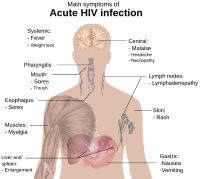
Photo from wikipedia
Objectives To compare cone beam computed tomography (CBCT) and magnetic resonance tomography (MRT) in patients with temporomandibular joint (TMJ) arthralgia in respect of the evaluation of bony structures, and to… Click to show full abstract
Objectives To compare cone beam computed tomography (CBCT) and magnetic resonance tomography (MRT) in patients with temporomandibular joint (TMJ) arthralgia in respect of the evaluation of bony structures, and to correlate joint space distances measured in CBCT with the morphology and the position of the disc visualized in MRT. Materials & methods 26 temporomandibular joints (TMJs) in 13 patients clinically diagnosed with TMJ arthralgia were examined by both CBCT and MRT. All images were evaluated by use of a form. The results were compared in regard of conformability of the diagnoses of osseous structures established by each imaging method. Anterior, superior and posterior joint space distances measured in CBCT-images were related to disc morphology and position visualized in MRT. Results Conformability of CBCT and MRT in the evaluation of bony TMJ structures ranged from 69.3 to 96.6 %. Osseous alterations such as erosions, osteophytes and cysts detected by CBCT could partly not be discerned by MRT. The correlation of joint space distances with disc morphology (biconcave or not biconcave) was not statistically significant. The correlation of joint space distances and disc position was statistically significant only for the superior joint distance. Conclusion CBCT outclasses MRT in the visualization of osseous alterations, which are diacritic in the differentiation of simple arthralgia from osteoarthritis. Therefore, CBCT imaging is appropriate in patients clinically diagnosed with TMJ arthralgia. Superior joint space distance not being the highest joint space in sagittal CBCT indicates an anterior disc displacement. For the visualization of structural changes or displacement of the disc frequently associated with osseous changes, MRT is the optimal tool. Thus, the combination of the two imaging methods allows a comprehensive diagnosis in TMJ arthralgia patients.
Journal Title: Heliyon
Year Published: 2018
Link to full text (if available)
Share on Social Media: Sign Up to like & get
recommendations!